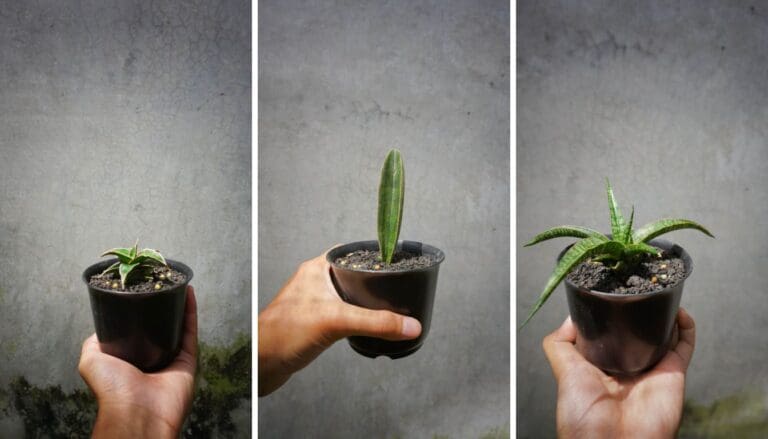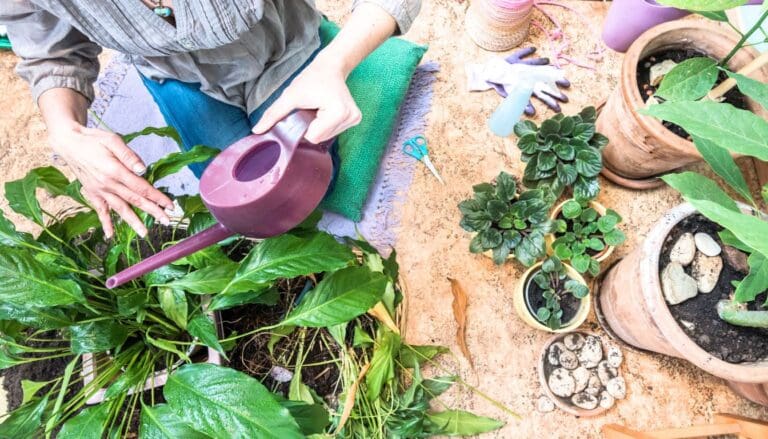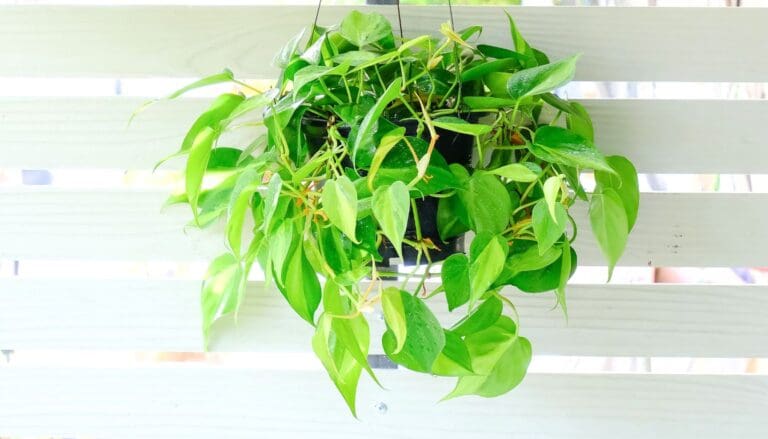What Kind Of Light Does English Ivy Need?
English Ivy plants are evergreen perennials that can be grown in hanging baskets, as a climber, or as a ground cover. If you are thinking of bringing this beauty home, you might be wondering what kind of light it needs. Let’s find out.
English Ivy requires bright light but cannot tolerate intense direct sunlight. If you keep them in a medium or low light zone, they may survive, but the variegated forms will lose their color and turn green, the growth rate will decrease, and the plant will get leggy.
In this article, I will understand the different types of lighting and what is right for your English Ivy plant.

Please note: Simplify Plants is reader-supported. Some links in the post are affiliate links and I get a commission from purchases made through links in the post.
Importance of good lighting
Light is among the basic elements plants need to make food and grow.
The plat cannot prepare enough energy without sufficient light, rendering it weak and leggy.
And then, too much light can also burn the leaves, making them yellow and dehydrated.
Thus, for the best growth of your English Ivy, it is crucial to understand its lighting needs.
English Ivy plants are grown for their lush, bright foliage and are easy to care for as long as they get suitable growing conditions.
When they are happy in their environment, they reward you with tiny flowers.
The most important part of caring for your English Ivy is providing it with the right light.
What kind of light is needed for English Ivy?
In nature, English Ivy grows extensively as ground covers or as trailing plants because of their aggressive growth.
They are accustomed to light shade or dappled light, so when you grow them as houseplants, you must give them a similar environment.
English Ivy thrives in indirect bright light during summers.
But in areas with harsh cold winters, you can give them some direct sunlight to keep them warm.
Before getting into more details about the lighting conditions, let us look into this simple table to understand the different types of lighting in our homes:
| Types of light | Light intensity in Foot candles | Location |
|---|---|---|
| Full sunlight (At least 6 hours of sunlight) | 32,000-100,000 FC | – Window sill – Open balcony – Sunroom |
| Filtered sun, Partial sun, Dappled sun (Between 3-6 hours of direct sun) | 10,000-25,000 FC | – 2 feet from the east/south window – Sheer curtains |
| Indirect light, Bright light | 500-1000 FC | – No direct sun but brightly lit – 2-3 feet from a well-lit window |
| Medium-light | 100-500 FC | – Around east, west, or north windows without direct sunlight – Patios |
| Low light | <100 FC | – Basement – Room without windows – Staircases, bathrooms, halls |
Direct vs. indirect light
We often come across these terms while discussing the plants’ lighting requirements.
Plants that require direct sunlight mean they need the direct sun rays falling on them.
Examples include fruit-bearing plants, some flowering plants, and cacti and succulents.
Plants requiring indirect sunlight are mostly native to areas where they grow under bigger trees or forest floors.
They get dappled sunlight and are partly shaded by other plants.
This makes them ideal houseplants as they grow indoors where direct sunlight is unavailable.
Examples of these plants include houseplants, including English Ivy.
However, you must note that though they do not require direct sunlight, they need a lot of bright light.
If you keep them in low lights, they will not be able to grow well.
Exposure to sun

English Ivy in nature grows in woodlands, forest edges, and upland areas of Europe.
Depending on their variants, their light requirements change.
The green-leaved ones do well in partial or bright indirect light, but the variegated ones need full to partial sunlight to maintain their color.
Without some direct sunlight, the variegations start to turn green because the plant produces more chlorophyll in the absence of enough light.
At the same time, they do not like being exposed to scorching direct sunlight, which leads to sunburn.
The leaves turn yellow or brown and develop spots; the soil dries due to too much sun.
It took me some time to understand this, and I lost a few English Ivy plants.
But after much research and trial and error, I finally know how much sun is right for my Ivy.
The direction of the sun
You must have a basic knowledge of the directions and positions of the sun.
The following will help you to find the best spot for your English Ivy.
- East – An east-facing spot is ideal for most houseplants as it gets the morning mild sun rays. Most foliage plants that enjoy dappled or indirect sunlight grow the best in east-facing windows or balconies. My English Ivy is growing on an east-facing balcony, and it is happy as it gets a few hours of morning sunlight and indirect light throughout the day.
- West – A west-facing spot receives the late afternoon sunlight, which can get intense. If your houseplants receive it, you may burn the leaves in summer. If you keep your English Ivy in a west-facing spot, make sure you put up a sheer curtain or put the plant a few feet away from the light source.
- North – North-facing spots have the lowest light, making them unsuitable for plants needing bright or direct light. It may lose its colors if you keep your variegated English Ivy in such a spot. The green variants will survive, but the growth rate will be slower, and the plant might get leggy.
- South – South-facing balcony or window does not have access to direct sunlight, but they are extremely bright. So most houseplants, including your English Ivy, will enjoy the south-facing spot for maximum growth.
To sum it up:
| Direction | Impact |
|---|---|
| East | The mild morning sun is perfect for your English Ivy. |
| West | Hot afternoon sun can lead to sunburn. |
| North | Low light is fine for summers but not suitable for colder climates. |
| South | Indirect bright light is suitable for your English Ivy. |
Summer vs. winter lighting need

Along with the direction of sunlight, the seasonal change also impacts light intensity.
In summers, the sunlight is hot, and the intensity is extremely harsh.
When your English Ivy is exposed to this hot sunlight, it gets burnt and dehydrated.
This hot summer sunlight is unsuitable for most houseplants.
Thus, you must protect them by putting up sheer curtains or bringing the plants away from direct sunlight.
On the contrary, the winter sunlight is milder.
3-4 hours of sunlight in the winters help the plants immensely to get some warmth.
| Seasons | Lighting needs |
|---|---|
| Summers | Bright indirect light |
| Winters | Direct sunlight in the morning and bright indirect light for the rest of the day |
Best spot for English Ivy
Keeping your English Ivy in a spot with insufficient light will make them leggy and pale.
The best spot for your English Ivy plant is either an east-facing window balcony where the plant will get early morning sunlight but protection from the afternoon sun or a south-facing spot where it gets bright light throughout the day without direct sun exposure.
Impact of too much light on English Ivy

Placing your English Ivy under scorching sunlight can damage your plant by leaving it sunburnt and scorched.
If you live in a cooler region, your Ivy may do fine under direct sunlight, but in the warmer regions, you must put them in bright indirect sunlight.
Some of the signs of your Ivy getting too much light are:
- Sunburn
- Dry and compact soil
- Dehydration
- Yellow leaves
- Brown spots on leaves
What to do if my English Ivy gets too much light?
If you mistake putting your delicate English Ivy under scorching summer sunlight, it will get a sunburn.
Let us discuss what can be done to help the sick, dehydrated plant.
- When you notice the signs of too much sun exposure on your plant, the first step is to shift its location.
- Before shifting, you must know that you cannot shift it to a low-light area. Then your plant might not survive the stress. You have to choose a spot that has bright light but stays protected from direct sunlight.
- Once you have moved the plant, prune with a sterilized pruner, and do not forget to wear gloves. And start by trimming off all the yellow, brown sick-looking leaves. These leaves cannot go back to their original color, so it is best to prune them off.
- Now fill a large bucket or container with water and put the plant in it. Let it soak up the moisture for 10-15mins.
- Take the plant out and let it enjoy the bright light and hydrated soil.
- Do not water until the topsoil gets dry.
Effects of low light on your English Ivy

English Ivy enjoys bright indirect light, but it will not be suitable for your plant if it does not get the required light.
Low light can be equally dangerous to your plant’s health, like too much light.
English Ivy is adaptable to shaded spots like patios or bright north-facing windows, but keeping them in extremely low-light areas like basements, rooms without windows, or darker areas will not be fine.
Even though the green variants can survive in low light, the variegated versions of the Ivy need a lot more light to maintain their colors.
The plant’s growth rate will visibly decline and start growing leggy.
The plant will no more appear full and bushy and vibrant.
Those low light conditions also increase the chances of pests’ infestations, fungus, and root rot.
Some of the signs that your plant is getting insufficient light are:
- Leggy growth – One of the first signs that your Ivy needs more light is that the space between the leaves increases. They appear to be more spaced out.
- Smaller leaves – The sizes of the leaves also start getting smaller with insufficient light.
- Soggy soil – In the absence of sufficient light, the soil stays wet for a longer period. The evaporation rates are lower.
- Stunted growth – When the lights are low, the photosynthesis process also reduces, making the plant’s growth slower.
- Pest and fungus attacks – Insufficient light and ventilation are major reasons for plants’ fungus and pest growth. So if your Ivy is attacked by those bugs frequently, try moving it to a well-ventilated and bright area to see if it improves.
What to do if your English Ivy does not get too much light?

So if you see the above symptoms in your plant and realize it is not getting enough light, then here is what you should do.
- First, move your plant to an area with a lot of bright light but not direct sun.
- You can invest in artificial lights if your home does not have sufficient natural light. Keep the plants a few feet under these lights, and they will do just fine. These lights can also help during winters as they help keep the plants warm.
- In lower light areas, fertilize your Ivy less often because the growth is slower. The fertilizer might accumulate in the soil and cause root burn.
- In low light areas, keeping a check on the watering is very important as lower evaporation gives more chances of root rot and overwatering. So before watering your plant, makes sure the soil is completely dry.
- One important step to follow if your English Ivy is kept in a low-light area is to keep the leaves of your plant clean. To do that, wipe the leaves with a clean cloth but do not keep them wet for long as wet leaves attract fungus and pests. Clean leaves help increase the photosynthesis process, which reduces due to lower light availability.
- In low-light areas, you must rotate your plant weekly so that all the sides get even light. This is because, in such situations, the plant begs to bend to one side towards the distant light source, dampening its aesthetic.
Final thoughts
The right lighting is an extremely vital factor in caring for any plant. If all the other care needs are met, but the lighting is not right, your plant is bound to suffer. This is because light helps the plant to make its food.
English Ivy is a gorgeous plant that is popular because of its adaptability to many lighting conditions, but as they say, anything too extreme is harmful.
If you own the variegated variants, keep them at spots that receive partial sunlight or full sun in cooler regions. However, in hot weather, avoid full sun. The green variants can tolerate medium or lower lights. However, their growth and health might get hampered.
It can tolerate both direct sun and full shade, but depending on the weather and region, you can tweak the rules if you want it to flourish. Some direct light in winters and summers gives it bright indirect light. Once you learn the balance, your plant will thrive and grow.
Reference: Researchgate, University of Tennessee, Mississippi State University, Central Florida Research and Education Center, U.S. DEPARTMENT OF AGRICULTURE.
Recommended Garden Supplies
| Product Image | Our Recommended Gardening Supplies | Check Offers! |
|---|---|---|
Top Top
Top
Top
Top
Top
Top
Top
Top | rePotme Houseplant and Tropical Classic Potting Soil Mix | Check Offer On Amazon |
 Top
Top
Top
Top
Top
Top
Top
Top | Espoma Organic Indoor Plant Food | Check Offer On Amazon |
 Top
Top
Top
Top
Top
Top
Top
Top | GooingTop LED Grow Light 6000K Full Spectrum Clip Plant Growing Lamp | Check Offer On Amazon |
 Top
Top
Top
Top
Top
Top
Top
Top | Soil Moisture Meter | Check Offer On Amazon |
 Top
Top
Top
Top
Top
Top
Top
Top | Govee Hygrometer Thermometer, Bluetooth Enabled! | Check Offer On Amazon |
 Top
Top | LEVOIT Humidifiers for Large Room(Best For Plants) | Check Offer On Amazon |
 Top
Top
Top
Top
Top
Top
Top
Top | Upgraded DIY Automatic Drip Irrigation Kit, 15 Potted Houseplants Support | Check Offer On Amazon |
 Top
Top
Top
Top
Top
Top
Top
Top | Stainless Steel Heavy Duty Gardening Tool Set | Check Offer On Amazon |
 Top
Top
Top
Top
Top
Top
Top
Top | Bonide Insecticidal Soap | Check Offer On Amazon |
 Top
Top
Top
Top
Top
Top
Top
Top | Bonide 32 oz Spray Neem Oil for Organic Gardening | Check Offer On Amazon |
 Top
Top
Top
Top
Top
Top
Top
Top | Garden Safe Fungicide | Check Offer On Amazon |






